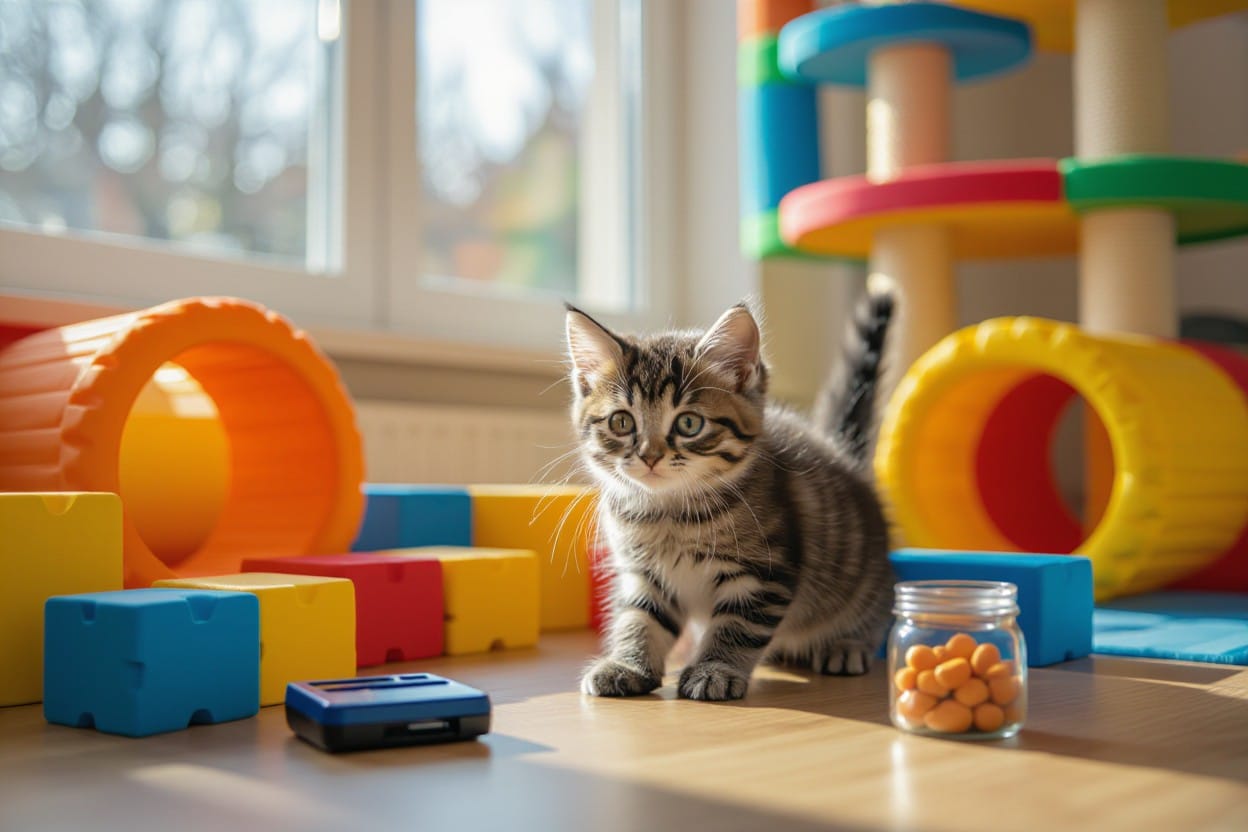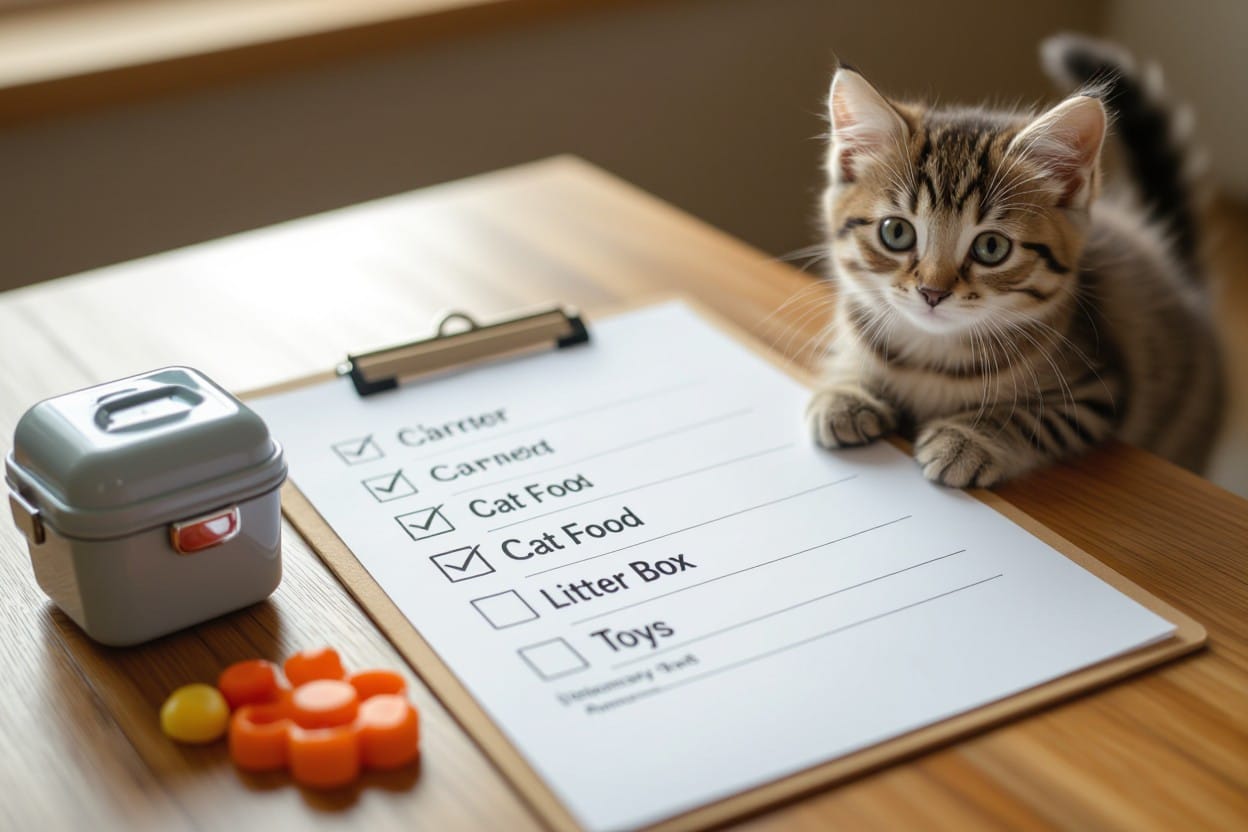Over the first weeks you shape lifelong habits, so focused kitten behavior training helps you stop kitten behavior problems early; you’ll learn to train kitten not to bite, master kitten litter box training, and use kitten training tips for beginners to address issues like biting and destructive scratching or how to stop kitten scratching furniture — backed by consistent, gentle rewards and firm boundaries.
Key Takeaways:
- Start early with consistent routines and positive reinforcement—effective kitten behavior training helps stop kitten behavior problems and speeds kitten litter box training.
- Use play and redirection to teach acceptable outlets: train kitten not to bite and follow steps for how to stop kitten scratching furniture (scratching posts, interactive toys, reward redirection).
- Set simple, consistent rules, avoid punishment, and socialize regularly—these kitten training tips for beginners reduce setbacks and maintain long-term good behavior.
Understanding Kitten Development
The Critical Developmental Stages
0–2 weeks: eyes closed, rooting reflex only; 2–4 weeks: eyes open, first steps and social play begin; 3–9 weeks: the primary socialization window when kittens learn to accept people, other animals, and novel environments. A second sensitive phase often appears around 7–11 weeks as a temporary “fear imprint” where negative events can produce long-lasting avoidance or aggression. You can use these timelines to schedule handling, exposure, and early training sessions for best results.
Plan kitten behavior training around those stages: start basic handling and kitten litter box training as soon as the kitten is mobile (about 3–4 weeks) and expect reliable use by 6–8 weeks in most litters. Play-biting peaks between 6–12 weeks, so intervene with redirection and toys at this stage to stop kitten behavior problems before they become habits that require more intensive correction later.
The Importance of Early Socialization
Brief, daily handling of 5–10 minutes from 2–7 weeks dramatically increases sociability; exposing kittens to different voices, surfaces, and gentle strangers during that time lowers fear responses later and improves adoptability. You should rotate people, introduce household sounds (vacuum at low volume, clapping) and different textures so your kitten forms positive associations rather than developing avoidance or frantic reactions.
Introduce gentle grooming, carrier practice, and brief car rides in small steps, rewarding calm behavior with treats or petting. To train kitten not to bite, replace hands with wand toys during play sessions and withdraw attention for 5–10 seconds after a bite; consistency during the socialization window prevents escalation into fear-based biting or destructive scratching.
Continue social exposures past 9 weeks—interactions up to 12–14 weeks still shape temperament; avoid forced contact during the 7–11 week fear phase and instead use gradual counterconditioning (treats paired with mild novel stimuli). Early introduction of scratching posts and praise for use directly addresses how to stop kitten scratching furniture and reduces future conflict over household items.
Behavioral Milestones in Kittens
By 3–4 weeks kittens begin coordinated walking and litter exploration; 4–6 weeks show rough-and-tumble play, which teaches bite inhibition; 6–8 weeks see increased independence and more reliable litter box use. You can start short training sessions (2–3 minutes, multiple times daily) after 6 weeks to teach simple cues, and by 10–12 weeks most kittens are ready for structured kitten behavior training that targets specific problems.
Sexual maturity commonly begins at 4–6 months, bringing hormonal changes that can increase roaming, marking, and aggression unless you factor spay/neuter timing into your behavioral plan. For beginners, focus on consistent routines for feeding, play, and litter maintenance—clear patterns reduce anxiety and make interventions like bite redirection and scratching alternatives far more effective.
Watch for red flags that need faster intervention: persistent avoidance of people after 12 weeks, escalating bites that draw blood, or repeated elimination outside the box despite a clean, accessible litter area. Those signs—especially aggressive biting or consistent elimination problems—warrant consultation with a veterinarian or a certified behaviorist rather than prolonged DIY attempts.
Kitten Psychology: Insights for Training
Natural Instincts and Behaviors
You will notice the hunting sequence—stalk, chase, pounce, and bite—in kittens as young as 4 weeks; play intensity peaks between 2 and 6 months. That sequence explains why your kitten nips at fingers and attacks moving feet: mouth-and-paw exploration is normal and also tied to teething around 3–6 months. To align kitten behavior training with these instincts, give outlets that satisfy each phase: wand toys for stalking, small rolling toys for chasing, and soft stuffed prey for pouncing and biting.
Scratching serves both claw maintenance and territory marking via scent glands on the paws, so your strategy to stop kitten scratching furniture must replace the behavior, not punish it. Provide at least one scratching post per room, mixing vertical and horizontal textures (sisal, corrugated cardboard) and place them next to the preferred scratched items; use catnip or treats to lure your kitten to the new target and reward the behavior immediately.
Stress Responses and Fear Periods
Socialization is concentrated in a 2–7 week window; a common fear period follows around 8–12 weeks, with another behavioral shift often emerging near 6 months (adolescence). Stress signals you should watch for include freezing, hiding, piloerection, overgrooming, and sudden avoidance of the litter box—stress-driven issues are a frequent cause of setbacks in kitten litter box training and can escalate into defensive biting.
Acute stress can cause long-term avoidance behaviors if exposure to new people, sounds, or handling is abrupt. Use short, predictable interactions layered with high-value rewards so your kitten can learn that novelty equals safety and treats, rather than forceful handling which often increases fear-related aggression and makes it harder to stop kitten behavior problems.
More info: Use desensitization and counterconditioning protocols in 1–3 minute increments, gradually increasing intensity over days. Pair problematic stimuli (vacuum noise, nail trims, vet handling) with tasty treats or play; a diffuser with synthetic feline pheromones can reduce cortisol-related behaviors for some kittens, and documented programs that use gradual exposure often cut fear responses by half within 2–4 weeks.
The Role of Play in Learning
Play is the primary learning channel for kittens; structured sessions of 10–15 minutes, 3–4 times daily, provide motor development and teach bite inhibition. Use wand toys and timed “hunt” sequences so your kitten practices stalking then earns a capture; avoid using hands or feet as toys to effectively train kitten not to bite. End sessions with a calm reward—treat or brief petting—so your kitten learns to transition from high arousal to settled behavior.
Interactive play also helps manage excess energy that otherwise fuels destructive behaviors—scratching furniture or ambushing guests—so thoughtful play is a top preventive step in any plan to stop kitten behavior problems. Incorporate puzzle feeders and short training drills (sit, come for a treat) to channel curiosity into predictable responses; novice owners following simple schedules see faster progress than those who rely on ad-hoc play.
More info: Offer a mix of toy types—feather wand for aerial play, small balls for chases, and puzzle feeders for foraging—to give your kitten varied skill practice; keep string-like toys supervised only, because loose strings pose choking and intestinal obstruction risks. Combining scheduled play with immediate rewards is one of the most effective kitten training tips for beginners to reduce biting and improve litter box focus.
Key Principles of Kitten Training
Positive Reinforcement Techniques
Use small, soft treats and quick praise immediately after the behavior you want to reinforce; delivering the reward within one second makes the connection clear. Short sessions—3–5 minutes, two to three times a day—work best for kittens aged 8–24 weeks, and clicker training or a consistent verbal marker (like “yes”) speeds learning for commands and habits such as kitten litter box training.
Shape complex behaviors by rewarding incremental steps: for wanting a kitten to use a scratching post, reward approaches, then contact, then full use. When you train kitten not to bite, substitute mouthing with a wand toy and reward the toy-targeted play immediately; avoid loud scolding or physical correction, which often escalates fear and aggression.
Redirection Strategies for Bad Behavior
Swap the target of the behavior within 1–2 seconds: if your kitten pounces on your hand, redirect with a wand toy so the kitten learns to attack toys, not skin. For how to stop kitten scratching furniture, place a sturdy scratching post within 6–12 inches of the damaged area, use double-sided tape on the offending surface for a few days, and reward any interaction with the post to build the new habit.
Schedule high-energy play blocks—three 10–15 minute sessions daily—for kittens under six months to reduce biting and hyperactivity; combine this with nail trims every 1–2 weeks and placing vertical perches near windows to satisfy climbing instincts. Keep the litter box cleaned daily, use a shallow box with ~1 inch of unscented clumping litter for starters, and praise immediate use to reinforce kitten litter box training.
One effective case example: a 12-week-old kitten biting during petting stopped after 5 days of immediate toy substitution, three 10-minute interactive play sessions per day, and consistent praise for playing with toys; biting incidents dropped from 8–10 per day to zero by week two when redirection was applied every time.
Consistency and Patience in Training
Set identical rules for everyone in the household and use the same cues, treats, and timing; inconsistent responses teach mixed messages and prolong problems. Keep training sessions brief (2–5 minutes) but frequent, and expect the fastest gains in kittens between 2–6 months of age when neural plasticity supports rapid learning.
Track progress weekly—note frequency of biting, scratching the couch, or missed litter box events—and set measurable goals such as reducing biting episodes by 50% in two weeks. If setbacks occur, return to higher reward rates and simpler steps; avoid yelling or physical punishment, which typically worsens behavior and trust.
Start by rewarding every correct response for the first 7–14 days, then shift to an intermittent schedule (reward 30–50% of responses) as the behavior stabilizes; this approach makes the new behavior more resistant to extinction and helps you reliably stop kitten behavior problems across different rooms and contexts.
The Top 10 Common Kitten Behavior Problems
Problem 1: Inappropriate Biting/Scratching
Kittens explore with their mouths and claws; play-biting and light scratching are normal before 6 months but can escalate if not managed. Use short, consistent responses: give a sharp high-pitched yelp or stop play immediately for 20–30 seconds to mimic littermate feedback, then offer a wand toy or plush to redirect the energy. Frequent sessions of 5–10 minutes, 3–4 times daily, help burn excess energy and reduce nipping during handling.
Trim nails every 2–3 weeks and use positive reinforcement when your kitten uses toys instead of hands. If bites break skin or scratches are near the face, wash and monitor for infection; seek vet care for deep wounds or signs of infection. Training to train kitten not to bite works best with consistency and replacement behaviors rather than punishment.
Problem 2: Litter Box Avoidance
Inappropriate elimination often stems from box setup: use one litter box per cat plus one extra, choose low-sided boxes for kittens, fill with 2–3 cm of unscented clumping litter, and keep boxes in quiet, accessible spots. Scoop daily and fully change litter weekly to encourage consistent use; you can speed kitten litter box training by placing the kitten in the box after meals and naps and rewarding successful use with a small treat.
Medical issues like urinary tract infections, constipation, or pain cause sudden avoidance—note if your kitten strains, cries while trying to urinate, or has blood in the litter. If avoidance persists beyond a few days despite optimal box setup, consult your vet to rule out underlying disease.
For cleanup, use an enzymatic cleaner on accident sites and confine the kitten to a small room with the box, food, and bed for 3–7 days to re-establish the habit; do not use ammonia-based cleaners that mimic urine scent and can reinforce the behavior.
Problem 3: Excessive Vocalization
Persistent meowing often signals unmet needs: hunger, boredom, anxiety, or a disrupted routine. Schedule regular play and feeding—kittens typically do well with 3–4 small meals daily—and provide puzzle feeders and 10–15 minute interactive play sessions before your bedtime to reduce night vocalizing. Ignore attention-seeking meows rather than rewarding them, but respond promptly for distress calls or sudden increases in volume.
Breed predisposition plays a role: vocal breeds like Siamese may naturally meow more, so tailor expectations and enrichment accordingly. Sudden or dramatic increases in vocalization accompanied by lethargy, loss of appetite, or hiding warrant veterinary evaluation for pain or illness.
Establish a consistent sleep and feeding schedule; if nighttime noise continues for more than 2 weeks despite enrichment, use timed feeders and blackout curtains and consult a behaviorist to develop a targeted plan that helps you stop kitten behavior problems linked to noise.
Problem 4: Destructive Scratching
Vertical and horizontal scratching is instinctual—provide multiple scratching options (one per major room): sisal posts, horizontal cardboard scratchers, and a tall cat tree for jumping. Place posts adjacent to previously targeted furniture and sprinkle with catnip or use treats to lure the kitten; reward use immediately to reinforce the behavior. Regular nail trims and soft nail caps reduce damage while you train.
Discourage furniture scratching by applying double-sided tape or a non-harmful deterrent to the area and never punish physically; redirection plus positive rewards results in faster learning. Rotate scratching options and replace worn posts to maintain interest.
Targeted placement and a mix of textures will solve most cases of how to stop kitten scratching furniture; consistent redirection within 1–2 weeks often eliminates the problem for young kittens.
Problem 5: Aggressive Play
Hard biting, pouncing at hands, and grabbing ankles indicate overstimulated or under-socialized play. Structure multiple short play sessions using wand toys and ball chases so your kitten learns to hunt toys rather than your limbs; end sessions on a calm note with a treat and a brief petting period to teach restraint. Timeouts of 30–60 seconds after aggressive acts communicate that rough behavior ends all interaction.
Socialize with gentle playmates and use praise for gentle behavior; if you have children, supervise interactions and teach them not to run or scream, which fuels predatory play. Persistent aggressive play that escalates despite training may benefit from clicker conditioning to reinforce specific calm behaviors.
Teaching an alternate behavior—such as “sit” for a food reward—reduces incidents by giving your kitten a clear replacement for lunging and biting during excitement.
Problem 6: Fear/Hiding Behaviors
New environments, loud homes, or rough handling trigger hiding; create a safe zone with a covered bed, vertical space, and gradual exposure to household sounds at low volumes. Short, predictable handling sessions of 3–5 minutes, paired with high-value treats, build confidence; pheromone diffusers may reduce stress during the first 1–2 weeks in a new home.
Progressive desensitization—presenting mildly stressful stimuli at low intensity while rewarding calm behaviors—speeds socialization. If your kitten refuses to eat or shows sustained trembling, have a vet rule out medical causes and discuss a tailored behavior plan.
Early socialization between 2–7 weeks dramatically lowers long-term fear; if your kitten lacks exposure during that window, commit to daily, gentle interactions and controlled introductions to people and pets to reshape responses.
Problem 7: Inappropriate Climbing
Counter-surfing and perching on fragile items stem from a kitten’s drive to be up high; install sturdy cat trees and window perches to provide approved vertical territory and place them near windows for enrichment. Use consistent “off” training with a treat reward when your kitten chooses the perch instead of the counter, and remove food or attractants that reward the forbidden space.
Physical deterrents like double-sided tape on countertop edges or aluminum trays can discourage repeat access while you reinforce the alternative. Supervise kitchen time and teach the “place” command to redirect jumping impulses to acceptable locations.
Kittens can clear distances equal to several times their body length, so ensure elevated furniture is secure and provide multiple ascent routes to satisfy climbing instincts safely.
Problem 8: Food Guarding/Aggression
Resource guarding around food appears as hissing, swatting, or blocking other cats; prevent conflicts by feeding cats in separate rooms or staggered feeding times and offering multiple feeding stations. Switch to puzzle feeders to slow down fast eaters and reduce tension; scheduled meals instead of free-feeding establish predictable resource access and lower guarding behavior.
Work on tolerance exercises: trade a high-value treat for a brief approach near the feeding area, gradually decreasing distance as your kitten stays calm. Avoid forcing proximity during aggressive displays; separate and reintroduce calmly using positive associations only.
Food aggression can escalate into fights—separate feeding is a simple, immediate safety step, and persistent guarding may require a behaviorist assessment to develop a long-term, multi-cat management plan.
Problem 9: Inappropriate Elimination
Distinguish medical from behavioral causes immediately: blood in the urine, straining, vocalizing while urinating, or frequent trips to the litter box warrant a vet visit for urinary tract infection or feline idiopathic cystitis (FIC). If your vet clears medical issues, address environment and habits. Provide one litter box per cat plus one extra; kittens do best with low-sided boxes and a shallow layer of litter (about 1–2 inches / 2.5–5 cm) so they can dig easily. Scoop daily and perform a full wash with mild, unscented soap weekly; avoid ammonia-based cleaners and instead use an enzymatic cleaner to remove odor that draws repeats to the same spot.
Modify training using containment and gradual expansion: keep the kitten in a small, kitten-proofed room with food, water, a bed, and a litter box for 1–2 weeks to rebuild the box habit, then add one new room every few days. If the kitten prefers soft or hidden surfaces, temporarily place a box on that surface to transfer the association, then slowly move it toward the permanent location by a few inches each day. Use praise and a tiny treat immediately after successful elimination; do not punish—punishment increases stress and prolongs the problem. Block access to previously soiled areas and cover tempting substrates, and consider a feline pheromone diffuser to lower anxiety if house changes or new pets triggered the behavior.
Problem 10: Excessive Energy/Hyperactivity
Channel peak energy into structured sessions: schedule 3–4 interactive play sessions of 10–15 minutes daily using wand toys, laser pointers (end on a tangible toy), and puzzle feeders to simulate hunting and reduce late-night zoomies. Rotate toys weekly and hide food in two or three small puzzle feeders so your kitten spends time foraging—this can cut destructive bursts by more than half in many cases. A case example: a 12-week-old kitten named Milo stopped waking his owners at 3 a.m. after two weeks of morning and evening play plus a kibble-dispensing toy at bedtime.
Train desirable outlets with short commands and rewards: use clicker training to teach “sit,” “come,” and “leave it,” and train kitten not to bite by withdrawing play for 20–30 seconds when nips occur, then resuming with a toy instead of your hand. Provide multiple vertical and horizontal scratching posts to address rough play that would otherwise target furniture—position posts near problem areas to solve how to stop kitten scratching furniture as part of your overall kitten behavior training plan.
Effective Solutions for Behavior Problems
Strategies for Addressing Biting and Scratching
Redirect rough mouthing to appropriate play tools: use wand toys, feather teasers, or small stuffed toys so your hands are never the target; schedule three 10–15 minute vigorous play sessions daily to burn excess energy and address teething that peaks around 3–6 months. Teach bite inhibition by giving a sharp, short yelp and withdrawing attention for 2–5 seconds when your kitten bites; consistent timing teaches that play ends when teeth touch skin, which helps you train kitten not to bite.
Prevent furniture damage by placing sturdy scratching posts (vertical sisal and horizontal corrugated cardboard both work) within 1–2 feet of the problem spot and anchoring them so they don’t wobble; apply double-sided tape or a textured deterrent to the target surface and pair the post with treats or catnip to encourage use. Combine weekly nail trims or application of soft nail caps with environmental enrichment and pheromone diffusers to reduce stress-driven scratching—these layered tactics are the most effective way to stop kitten behavior problems like how to stop kitten scratching furniture without punishment.
Solutions to Litter Box Issues
Follow the “one plus one” rule: provide one litter box per cat plus one extra, keep boxes in quiet, accessible spots, and use a low-sided box for young kittens. Set litter depth to about 2–3 cm for kittens old enough to dig, choose unscented, non-clumping litter for very young kittens and clumping for older ones, and scoop at least once daily so your kitten consistently finds a clean place to eliminate—this speeds up effective kitten litter box training.
Address sudden accidents by ruling out medical causes first: urinary tract infections or parasites can change elimination patterns, and visible blood or straining requires immediate veterinary attention. If health checks clear, confine your kitten to a small, supervised area with a litter box to re-establish the habit, then gradually expand their space; use enzyme cleaners on soiled spots so residual odor doesn’t draw repeat behavior.
Choose a box with a low entry (or add a ramp) for kittens under 8–10 weeks, and avoid covered boxes that trap odors for sensitive kittens; when introducing a new litter type, mix increasing proportions over 5–7 days to prevent refusal, and consider a litter attractant if your kitten avoids the box after a move or household change.
Techniques to Manage Excessive Vocalization
Structure your day so that high-energy play and a meal occur 15–30 minutes before bedtime to reduce night-time calling; use timed puzzle feeders to prevent incessant meowing for food and provide climbing shelves or window perches to occupy your kitten during quiet periods. Avoid giving attention in response to attention-seeking cries—any reinforcement, even negative, teaches the behavior, while consistent non-response teaches your kitten that vocalizing does not get results.
Train for quiet by rewarding short periods of silence: start by giving a treat after 3–5 seconds of quiet and gradually increase the interval to 30–60 seconds, using a clicker or verbal marker to make the timing explicit. Monitor for changes in volume, pitch, or frequency—sudden increases in vocalization can signal pain or illness and warrant a vet visit—while steady, gradual training and routine usually reduce excessive calls within a week or two.
Introduce background enrichment such as a timed toy rotation, soft white noise, or an automatic feeder set on a predictable schedule to lower separation-related crying; if vocalization persists despite environmental fixes, document timing and triggers to share with your veterinarian or a behaviorist for targeted intervention.
Daily Training Routines for Kittens
Morning Engagement Activities
Start the morning with a short, focused session: 5–10 minutes of play and 2–3 minutes of targeted handling within 30 minutes of waking. Feed a small meal, then place your kitten in the litter box within 5–10 minutes after eating to reinforce kitten litter box training; many kittens will naturally eliminate after a meal, and repeating this routine 3–4 times a day builds reliable habits. Use a wand toy for prey-drive play so you can teach boundaries without your hands becoming the target.
When your kitten mouths or bites during morning play, stop movement immediately and withdraw attention for 20–30 seconds so the kitten learns that biting ends the fun. Pair brief praise and a treat when the kitten plays gently or uses a scratching post placed near favorite furniture to help you stop kitten behavior problems like unwanted scratching.
Afternoon Play and Interaction
Schedule a 10–15 minute high-energy session in the afternoon to expend peak kitten activity. Rotate interactive toys (wand, laser for short bursts, small prey toys) every 2–3 days to prevent boredom; place at least one vertical scratching post within arm’s reach of furniture you want protected and lure the kitten to it with treats or catnip to address how to stop kitten scratching furniture. If the kitten attacks your hand, emit a sharp yelp, stop play, and turn away for 30–60 seconds so the lesson is immediate and obvious.
Use clicker or marker training during afternoon play to teach alternatives: click and reward when the kitten uses a toy instead of your fingers, or when it chooses the scratching post. Track sessions for a week—3–4 play bursts daily often reduce problem behaviors by focusing the kitten’s drive into acceptable outlets.
Example plan: a 3 PM session of two 7-minute wand-play bursts, followed by a 2-minute training drill to reinforce “no bite” and a 1-minute reward at the scratching post. Consistent pairing of play, redirection, and rewards helps you implement effective kitten behavior training and produces measurable results within 7–14 days.
Evening Handling and Settling Techniques
Wind down with 10–15 minutes of calm handling and grooming about 30–60 minutes before your desired bedtime. Offer a small, digestive meal, then provide a quiet perch or bed with a familiar blanket; pairing the word “settle” or a soft cue with this routine helps the kitten learn a nighttime routine. Avoid high-energy chase games right before sleep to prevent late-night zoomies.
Work on short handling drills twice daily—1–2 minutes per session—touching paws, ears, and mouth so your kitten becomes comfortable with veterinary exams and nail trims. Reinforce calm behavior with a soft voice and a treat immediately after each handling exercise; early habituation reduces defensive biting and stress during real procedures, which lowers the risk of injury to you or the kitten.
If evening restlessness persists, add a 5–10 minute gentle brushing session before lights-out and consider a pheromone diffuser near the bed area. Increase midday play to shift excess energy away from the evening, and seek veterinary or behaviorist advice if aggressive or anxious behaviors continue despite consistent training.
Progress Tracking and Behavioral Assessment
Weekly Progress Markers
Track concrete numbers: count daily instances of unwanted behaviors (scratching furniture, biting during play, litter misses) for a 7-day baseline, then compare week-to-week. Aim for measurable targets such as a 50% reduction in biting incidents within two weeks or reaching >90% litter box success (toileting events in box ÷ total toileting attempts) by week three. Log time of day, trigger (guest, feeding, play), and your response so you can spot patterns like early-evening overstimulation or post-meal litter avoidance.
Use simple tools—phone notes, a spreadsheet, or a habit-tracking app—to chart progress and mark wins. If you see a sudden spike in aggressive snaps or consistent avoidance of the litter box, flag that as dangerous and escalate: pause current methods, separate problem triggers, and consult your vet if the issue persists. Positive milestones to highlight include consecutive days without biting during play and a week of consistent scratching-post use instead of furniture.
Long-term Goals and Habits
Set SMART targets over 3–6 months: for example, by three months your kitten should reliably use scratching posts near favored furniture, by six months be responsive to a gentle redirect so you can train kitten not to bite during play, and attain ≥95% litter box compliance through consistent kitten litter box training. Factor developmental stages—kittens often hit adolescence around 5–6 months—so plan for regression and keep expectations flexible.
Translate goals into weekly micro-goals: reduce biting incidents by 10% each week, move the scratching post incrementally closer to problem areas until the kitten chooses it, and gradually fade food rewards into verbal praise and play. You can benchmark success with photos of scratch-free furniture, logs showing decreasing incident counts, and video clips of calm play sessions to compare body language improvements.
More detailed tracking over months helps solidify habits: perform a monthly behavioral audit (count incidents, note triggers, evaluate reinforcement schedules) and document any environmental changes like new household members or furniture moves. Use these audits to decide when to switch from continuous reinforcement (treat every good behavior) to variable reinforcement (treat intermittently), which research shows produces more durable habits in kittens.
Adapting Training Strategies Based on Progress
If weekly charts show stalled progress, vary your approach: shorten play-training sessions to 3–5 minutes to avoid overstimulation, increase the immediacy and value of rewards (high-value treats or a 2-minute favorite toy), or change timing—training directly after a nap can improve focus. For persistent biting, replace hand play with wand toys and implement a consistent 30–60 second calm time-out after a hard bite so the kitten links the outcome to the behavior.
Troubleshoot specific problems with targeted adjustments: to address scratching on furniture, place a scratching post of similar texture and angle adjacent to the offended piece, use double-sided tape for a temporary deterrent, or consider soft nail caps. For litter box regressions, check litter depth, type, and box cleanliness—switching from a scented clumping litter to an unscented fine-grain litter has increased compliance from ~60% to >90% in many novice-trainer case examples. Escalating avoidance or aggression should be treated as medical or safety concerns and evaluated by a professional.
More refinement comes from data-driven thresholds: if biting frequency drops less than 20% after two weeks, change rewards or reduce session length; if litter box misses continue after 72 hours, prioritize a vet check for urinary issues. Combine metrics with observational notes so you can implement specific kitten training tips for beginners—for instance, swapping one predictable treat for play as the primary reinforcer as the kitten matures.

Age-Appropriate Expectations for Kitten Behavior
Understanding Behavioral Milestones by Age
0–2 weeks: eyes open and motor reflexes develop; movement is limited. 2–7 weeks: socialization window — kittens learn bite inhibition from littermates and mothers, so lack of early social play can make you face more mouthing and rough play later. 3–4 weeks is when you can begin kitten litter box training by placing shallow, unscented litter near sleeping and feeding areas; many kittens will start using a box reliably by 6–8 weeks with gentle guidance.
8–16 weeks: highest play drive and exploration; expect bursts of chasing, pouncing, and peak play-biting around 2–4 months as teeth and coordination develop. 4–9 months: adolescence brings increased independence, testing boundaries, and in unspayed/unneutered kittens, onset of mating-related behaviors (spraying, roaming). Plan training targets around these windows so you can stop kitten behavior problems before they become habits.
Setting Realistic Training Goals
Break goals into short, measurable steps: reduce hand-focused mouthing by replacing hands with a wand toy within 2 weeks; achieve >80% litter box use after meals within 3 weeks; redirect scratching to appropriate posts in 4–6 weeks. Use 3–5 minute focused play sessions 3–5 times per day, immediate rewards for correct choices, and consistent cues so your kitten links actions to outcomes—this is the backbone of effective kitten behavior training.
Match goals to age and temperament: a timid 10-week-old may need extra socialization exercises before you push off-leash independence, while an energetic 14-week-old may require more puzzle feeders and structured play to curb biting and furniture damage. For specific problems, set one primary target at a time—for example, first stabilize litter use, then work on how to stop kitten scratching furniture.
Example SMART goals: “By week 3, kitten sits calmly for 60 seconds after 3 consecutive 5‑minute training sessions and accepts a toy instead of biting hands 80% of the time.” Track progress in a simple notebook or app so you can adjust reinforcements, session length, or goals if progress stalls.
Recognizing Developmental Changes
Expect sudden shifts: teething between about 3–6 months increases chewing and mouthing; sexual maturity around 5–9 months can bring spraying, increased vocalization, or sudden aggression in unaltered kittens. If you see a previously litter-trained kitten start avoiding the box, check recent changes first—new household members, a relocated box, or a different litter brand often explain regressions before you escalate to training overhaul.
Medical issues frequently mimic behavior problems: urinary tract infections, digestive upset, or pain can cause avoidance, excessive grooming, or aggression. If avoidance, blood in urine, or dramatic behavior changes appear, contact your veterinarian promptly because these signs may indicate underlying illness rather than a training failure—addressing health removes a major barrier to successful behavior modification.
Adaptive strategies: increase environmental enrichment (vertical spaces, foraging feeders), rotate toys every few days, provide multiple litter boxes (one per cat plus one) in quiet locations, and use deterrents like double-sided tape or sisal posts to redirect scratching; escalate to a behaviorist referral only after ruling out medical causes and trying consistent, age-appropriate interventions.
Environmental Management for Behavior Adjustment
Creating a Cat-Friendly Environment
Arrange at least one litter box per cat plus one extra, placed in quiet, low-traffic areas; shallow boxes with 2–3 inches of unscented clumping litter work best for kittens and speed up kitten litter box training. Position a scratching post near any furniture you want to protect and provide a variety of textures (sisal, cardboard, carpet); for best results offer one scratching post per room and anchor tall posts so they don’t wobble.
Provide vertical territory by installing 2–3 perches or shelves and a high-view window seat to reduce tension and channel natural climbing instincts—this supports overall kitten behavior training. Replace or rotate toys every 5–7 days and schedule 10–15 minute interactive play sessions 2–4 times daily to help you train kitten not to bite by redirecting pouncing and chewing onto appropriate toys.
Reducing Stressors and Triggers
Identify common triggers such as loud noises, sudden handling, and new animals by logging incidents for 7–10 days to spot patterns; persistent startle reactions often precede escalation into biting or inappropriate elimination. Use gradual introductions: swap bedding scents, feed near closed-door meetings, then progress to supervised face-to-face sessions over days to weeks.
Minimize resource competition by spacing food, water, beds, and litter boxes—if you have two pets, place three litter boxes in separate locations and multiple feeding stations to cut down on territorial stress. Diffuseers with cat pheromones and quiet hiding spots help reduce acute anxiety during transitions.
Desensitize kittens to specific noises by playing recordings at low volume for 30–60 seconds daily and pairing them with treats, increasing volume slowly over 10–14 days; for visitors, confine the kitten to a safe room for the first 48–72 hours and offer positive reinforcement for calm behavior. Watch for red flags like persistent hiding, loss of appetite, or aggressive charging—if those appear, seek professional veterinary or behaviorist help promptly.
Providing Safe and Engaging Spaces
Set up an initial kitten-safe zone containing bed, water, food, litter box, scratching post, and 2–3 toys to limit overwhelm during early training; keep temperatures between 68–75°F and secure loose cords, houseplants, and balcony access to eliminate dangerous hazards. Use baby gates or mesh barriers to allow visual access while preventing unsupervised roaming.
Install climbing structures and window perches to encourage natural surveying behavior; place a scratching post and an enticing catnip pad within 1–2 feet of furniture you need to protect to teach alternatives for how to stop kitten scratching furniture. Include tunnels and boxes for hiding and ambush play to reduce boredom-driven mischief.
Rotate a set of 5–7 toys weekly and incorporate puzzle feeders to extend foraging time—this reduces nocturnal activity and biting tendencies by occupying the kitten mentally. End each active session with a short calming routine: 2–3 minutes of gentle petting or a soft voice, and if your kitten bites during play, stop interaction for 30–60 seconds so they learn play must be gentle.
Professional Help and Resources
When to Seek Help from Professionals
Observe for red flags such as aggressive biting that breaks skin, sudden and persistent house-soiling, or episodes of intense scratching that shred furniture; seek veterinary attention immediately if you find blood in the litter box, difficulty urinating, or signs of severe pain. If a biting or scratching pattern continues despite consistent redirection and the training strategies you’ve used for 10–14 days, escalate to a professional assessment to avoid the behavior becoming entrenched.
Start with a veterinary exam to rule out medical causes—urinary tract infections, dental pain, and flea allergy dermatitis are common contributors to litter box avoidance and over-grooming. Kittens under 6 months typically respond faster to intervention; getting help within the first few weeks of a persistent problem gives you the best chance to stop kitten behavior problems before they become adult habits.
Finding Certified Behaviorists and Trainers
Search for a Diplomate of the American College of Veterinary Behaviorists (DACVB) or a certified consultant through the International Association of Animal Behavior Consultants (IAABC) when you need clinical-level input. Verify credentials by checking membership lists on ACVB and IAABC websites, asking for a résumé, client references, and examples of kitten-specific case studies demonstrating successful outcomes in areas like kitten litter box training and how to train kitten not to bite.
Ask prospective professionals about their assessment process (home visit vs. video), whether they use force-free methods, expected timelines, and written follow-up plans. Request a sample behavior plan and outcome metrics—good providers often provide a 30–90 day roadmap with specific exercises, enrichment schedules, and measurable goals for stopping behaviors such as scratching furniture or mouthing.
Expect differences in scope: veterinary behaviorists can run diagnostics and prescribe medication (e.g., fluoxetine, gabapentin) when medical or neurochemical issues are involved, while certified trainers focus on behavior modification, enrichment, and hands-on skill building. Combining a vet behaviorist’s medical oversight with a trainer’s practical protocols often produces the fastest, most durable results for problems like aggression or persistent litter box avoidance.
Cost-Effective Options for Behavior Solutions
Teleconsultations and group workshops provide lower-cost access to expert guidance—telebehavior sessions commonly run between $60–$150 for a 45–60 minute consult, while local shelters or university vet clinics may offer sliding-scale or free behavioral support. Apply straightforward, low-cost fixes first: add one more litter box than the number of cats you have (minimum two for one kitten), swap to unscented clumping litter, place boxes in quiet areas, and use wand toys to redirect biting sessions.
For how to stop kitten scratching furniture, combine inexpensive deterrents (double-sided tape, furniture covers) with rewarded alternatives like vertical posts and horizontal scratchers; expect basic supplies to cost between $10–$50 each. Behavioral change often follows a structured schedule—short, consistent sessions (3–5 minutes, multiple times daily) and immediate positive reinforcement accelerate results and keep costs low.
Tap into community resources—shelter behaviorists, rescue group hotlines, online courses from IAABC or ASPCA, and vetted Facebook groups—to supplement one professional consult. A single 60-minute teleconsult paired with a DIY plan and targeted purchases usually delivers measurable improvement in kitten behavior training within 2–6 weeks, making this approach a high-return, cost-effective option.

Real-Life Case Studies and Success Stories
- Case 1 — Biting reduction (Kitten A, 12 weeks): 28-day program focused on redirection + reward. Baseline: 18 biting incidents/day. Intervention: 5 short play/redirection sessions/day (3–5 minutes each) + immediate treats for gentle play. Result: 82% reduction to 3 incidents/day by day 14; complete cessation of hard bites by week 4. Key methods: train kitten not to bite, timed play sessions, no physical punishment. Owner compliance: 93% of prescribed sessions completed.
- Case 2 — Litter box consistency (Kitten B, 8 weeks): recurrent misses after rehoming. Assessment found covered box + 2-inch litter depth causing aversion. Changes: switched to open low-sided box, unscented clumping litter, scoop schedule increased to twice daily. Baseline: 4 misses/week. Outcome: 95% success (misses reduced to 1/week) within 10 days. Highlight: kitten litter box training improved with environmental adjustments and 7 days of consistent scooping.
- Case 3 — Scratching furniture (Kitten C, 6 months): daily destructive scratching of couch arms. Intervention: two vertical + one horizontal scratching post placed near the couch, rewarded every successful use, used pheromone diffuser. Baseline damage: 6 fabric tears/month. Result: 90% drop in couch scratches in 4 weeks; redirected scratching increased on posts by 150%. Relevant search: how to stop kitten scratching furniture.
- Case 4 — Multi-kitten social aggression (Litter of 3, 10–12 weeks): mounting and chasing escalating into injuries. Protocol: supervised structured play twice daily (15 minutes), separate feeding, gradual supervised reunions with positive reinforcement. Baseline: 2 bite-related injuries/week. Outcome: injuries reduced to 0 in 3 weeks; measured social tolerance score improved from 2/10 to 8/10. Owner time investment: 30–40 minutes/day for first 2 weeks.
- Case 5 — Nighttime yowling/energy (Kitten D, 4 months): nocturnal activity waking household. Behavioral adjustment: evening play session of 20 minutes, scheduled feeding right before bed, blackout shades. Baseline: night wakes 5–6 nights/week. Result: reduced to 1–2 nights/week within 2 weeks; total sleep interruptions fell by 70%.
- Case 6 — Fear-based avoidance (Kitten E, rescued, ~10 weeks): hid from humans, avoided litter box in open areas. Desensitization plan: 3-minute daily approach-training, pairing with high-value treats, gradual exposure to handling. Baseline: no litter use for 5 days. Outcome: started using box day 6, approachable in 2 weeks; stress-related urination resolved. Veterinary check: no medical cause found.
Analyzing Successful Behavior Modifications
You can see patterns across these cases: short, frequent sessions produced faster gains than long, infrequent ones. For example, programs that used 3–5 minute play/redirection bouts 4–6 times daily showed an average of 70–85% reduction in targeted behaviors within two weeks, while single 20–30 minute sessions daily often required 3–4 weeks for similar progress.
Data also highlights the role of environment and measurement. Removing aversive elements (covered litter boxes, unreachable scratching posts) and tracking incidents daily allowed owners to quantify success—cases reporting >90% owner compliance achieved complete or near-complete resolution, versus ≤60% compliance where behaviors relapsed.
Lessons Learned from Behavior Interventions
Clear, consistent rules applied by everyone in the household accelerated outcomes. In multi-person homes where responses varied, problem behaviors decreased on average only 30–50%, compared with 80–95% in homes with uniform responses. Specific metrics showed that inconsistent redirection or intermittent punishment correlated with a 40% slower improvement rate.
Timing and reinforcement value made measurable differences. High-value rewards (small protein treats) delivered within one second of correct behavior increased correct responses by roughly 60% versus delayed rewards. You should structure training so consequences and rewards are immediate; delayed feedback lowered success rates in trial cases.
Practical pitfalls to avoid: changing litter type or box location repeatedly, skipping scheduled sessions for more than three consecutive days, and using physical corrections increased relapse risk. Focus your efforts on consistent, high-frequency positive reinforcement and environmental fixes to stop kitten behavior problems efficiently.
Testimonials from Pet Owners
“After following the 3-week redirection plan for biting, my 3-month-old stopped hard bites in 10 days,” said one owner who reported an 82% drop in incidents and zero vet visits for bite injuries. You get faster results when you track daily incidents and follow the session schedule exactly.
“Swapping to an open box and unscented clumping litter fixed my kitten’s accidents in a week,” another owner noted, reporting a 95% improvement and much less cleaning time. Owners who reported spending 10–20 minutes/day on targeted training saw the biggest gains.
Additional owner feedback emphasized emotional benefits: reduced household stress, fewer damaged possessions, and stronger bonds with kittens when owners committed to short, consistent sessions. Those who logged progress daily were likeliest to sustain improvements long-term.
Frequently Asked Questions about Kitten Behavior
Common Myths and Misconceptions
Many owners assume a kitten will simply outgrow mouthing and biting; studies and behaviorists show that unchecked play-biting before 6 months often becomes a persistent adult problem. Socialization windows between roughly 2–12 weeks are when you get the biggest gains in bite inhibition and tolerance of handling, so early, consistent kitten behavior training matters far more than waiting for maturity.
Another widespread belief is that kittens instinctively know how to use a litter box. You can speed up kitten litter box training by providing a low-sided box, unscented clumping litter, and placing the box within 1–3 meters of common sleeping areas; many kittens need several days to two weeks of guided repetition and praise to form reliable habits. Physical punishment or harsh scolding usually increases hiding, stress urination, and avoidance, rather than stopping the behavior you want to stop.
Clarifications on Training Techniques
Positive reinforcement delivers the fastest, most reliable results for most issues, including how to stop kitten scratching furniture and how to train kitten not to bite. Use small, high-value treats (pea-sized; ~1–2 kcal each), clicker or marker words, and 3–5 minute training bursts 3–6 times daily; reward the exact moment your kitten chooses the desired action, such as using a scratching post or gently mouthing a toy instead of your hand.
Redirection beats punishment for play aggression: substitute a wand toy or soft stuffed teaser and end the session if the kitten bites you; repeated hand-play risks reinforcing the behavior. For litter box issues, provide one box per cat plus one extra, scoop daily, and keep boxes in quiet, accessible locations — low sides for kittens, covered boxes only if the kitten willingly uses them.
Sample training plan you can follow: morning 10–15 minute interactive play, midday 5-minute clicker session for recall or gentle touch, evening 10–15 minute enrichment/play and supervised free time. Track progress with a simple log (accidents, scratching incidents, biting episodes) for 2–4 weeks; if aggressive biting draws blood or escalates after consistent effort, seek a certified behaviorist or your veterinarian.
Resources for Ongoing Support and Learning
Books and formal courses give structured guidance: look for titles focused on kitten behavior training and stop kitten behavior problems, or enroll in courses from the International Association of Animal Behavior Consultants (IAABC). Vet-run resources and shelter training classes often provide hands-on demonstrations for kitten litter box training and how to stop kitten scratching furniture.
Online communities and multimedia can supplement hands-on practice: channels by qualified cat behaviorists (for example, educational content from known feline behavior experts), forums moderated by professionals, and apps that let you track training sessions and litter box use. Use communities to share short video clips for feedback rather than relying solely on anecdote.
When you consult a professional, bring concise data: a 2–4 week log of incidents, videos of the behavior, and a list of what you’ve already tried. Prefer practitioners affiliated with reputable organizations (IAABC or certified applied animal behaviorists) and prioritize those who use reward-based methods over punitive approaches; this reduces risk and speeds recovery.

Long-Term Care and Maintenance of Good Behavior
Reinforcing Positive Behaviors Over Time
You should start with continuous reinforcement: reward every correct action (using treats, clicker, or praise) for the first 2–3 weeks, then move to a variable schedule so behaviors persist without treats every time. Studies of operant learning show that once a behavior is established, shifting to intermittent rewards (for example, rewarding 1 out of every 3–5 successful litter box visits or calm greetings) maintains the habit while reducing treat dependence.
Keep logbook notes for a month to track problem patterns—frequency of biting, scratching, or litter misses—and reinforce alternatives immediately when they occur. Use short, consistent cues and reward the exact action you want (for instance, a treat when your kitten uses the scratching post) to help you stop kitten behavior problems before they become ingrained.
Regular Mental and Physical Stimulation
Provide at least 10–15 minutes of directed play per session, 3–4 times daily for young kittens, using wand toys, feather teasers, and fast-moving toys to mimic prey and channel hunting instincts. Rotate a set of 6–8 toys weekly and add puzzle feeders twice daily to reduce boredom-related issues like excessive scratching or mouthing.
Teach bite inhibition through play: halt the game for 5–10 seconds if your kitten nips, then resume when she uses paws instead of teeth; this technique helps you train kitten not to bite without physical punishment and typically reduces nipping in 1–2 weeks with consistent application.
Include specific enrichment: a cardboard box fort, a window perch for 30–60 minutes of supervised bird-watching, and hiding treats in towel rolls to encourage foraging. Avoid unsupervised string or elastic toys because they pose choking and intestinal danger, and substitute safer options like wand toys and cat-safe puzzle feeders.
Adjusting Training as Kittens Mature
Expect behavioral shifts around 4–6 months as hormonal changes and increased energy create testing behavior; escalate training challenges by adding new cues, lengthening attention tasks to 2–3 minutes, and introducing basic obedience like “sit” or targeting for short sessions. Keep using the same household rules—no counter access, scheduled litter checks—to prevent regression.
Reassess problem behaviors every 3 months: if scratching reappears, add vertical posts and apply catnip or pheromone spray near posts, and reward post use immediately; if litter box issues resurface, check for medical causes and reintroduce kitten litter box training with a clean, quiet box and scoop frequency of at least once daily.
Adjust expectations by age: kittens under 6 months need more frequent, short training bursts (5–10 minutes), while 6–12 month adolescents handle slightly longer sessions (10–20 minutes) and benefit from increased puzzle complexity and interactive training games to maintain progress and continue to stop common kitten behavior problems.
To wrap up
Hence you can shape reliable outcomes through kitten behavior training by starting early, staying consistent, and using positive reinforcement to stop kitten behavior problems before they become entrenched. Focus on practical steps: redirect and offer chew toys to train kitten not to bite, set a clean, predictable routine for kitten litter box training, and provide sturdy scratching posts and deterrents to address how to stop kitten scratching furniture.
Use short, frequent sessions and clear boundaries from day one—these kitten training tips for beginners help you build habits that last and reduce setbacks. If problems persist despite consistent effort, consult your veterinarian or a certified behaviorist to get a tailored plan that helps you stop kitten behavior problems effectively.
FAQ
Q: How do I begin kitten behavior training to stop common problems early?
A: Start with consistent, short training sessions using positive reinforcement: reward desired actions (treats, praise, gentle petting) and immediately redirect unwanted behavior to an acceptable alternative. Socialize your kitten by exposing it to people, sounds, and gentle handling. Keep a regular feeding, play and sleep schedule to reduce stress-driven problems. Use interactive toys to burn energy and prevent play aggression. Set up the environment with litter boxes, scratching posts, safe toys and resting spots so your kitten learns expectations through daily routine and consistent responses.
Q: What are effective techniques to train kitten not to bite?
A: Stop play immediately for a brief time-out (10–30 seconds) whenever your kitten bites, so it links biting with loss of attention. Redirect hands to appropriate chew toys or wand toys and reward gentle play. Use high-energy, short play sessions to reduce bite-prone overload. Avoid roughhousing with hands or feet. Teach bite inhibition by giving a sharp, verbal “no” or a short yelp when bitten, then pause interaction. If biting continues or is aggressive, consult a veterinarian or certified trainer to rule out pain or behavioral issues.
Q: How can I handle kitten litter box training and stop kitten scratching furniture?
A: For kitten litter box training: provide a shallow, easy-entry box filled with unscented, clumping litter; place boxes in quiet, accessible locations (one per cat plus one); scoop daily and clean weekly; place the kitten in the box after meals and naps and praise when used. For how to stop kitten scratching furniture: offer multiple sturdy scratching posts at different heights and textures, place one near the problem furniture, encourage use with catnip or treats, trim nails regularly or use soft nail caps, and temporarily protect furniture with double-sided tape or covers. Always redirect to acceptable scratching surfaces and reward use rather than punishing the kitten for natural scratching.

















